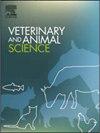将150 ~ 180 kJ的915 MHz微波能量有控制地应用于牛的前额,使牛完全从无意识中恢复过来
IF 1.9
Q2 AGRICULTURE, DAIRY & ANIMAL SCIENCE
引用次数: 0
摘要
对于消费者可以接受的清真和洁食牛肉,动物在放血时必须是活着的,没有受伤,如果在屠宰前失去知觉,如果没有放血,能够从无意识状态中恢复过来。电介质(电磁)系统,商标DTS:透热Syncope®(DTS)有可能满足这些要求。7头牛在150-180 kJ能量的DTS下昏迷。其中6只动物在DTS能量应用前后分别进行了脑电图(EEG),同时它们恢复了意识,而第七只动物则按照商业处理程序处理,没有收集EEG数据的延迟。5只动物(其中4只有脑电图记录)恢复后返回围栏,圈养30分钟,其间探索周围环境,吃干草,休息。观察期结束后,将其束缚,重新应用DTS能量,并将尸体加工供人食用。基于行为反应的意识丧失发生在能量应用开始后的10秒内,而脑电图显示失去知觉的持续时间为63秒(基于眼睛反射的缺失)或更长,需要很长时间才能完全恢复意识。动物完全从诱导的无意识中恢复过来,对环境刺激反应正常。当这些动物在康复后约30分钟第二次被送回约束箱时,没有发现厌恶的迹象。本文章由计算机程序翻译,如有差异,请以英文原文为准。
Cattle recover completely from unconsciousness induced by controlled application of 150–180 kJ of 915 MHz microwave energy to the forehead
For beef to be acceptable to consumers of Halal and Kosher meat, the animal must be alive at the point of exsanguination, undamaged and, if rendered unconscious prior to slaughter, able to recover from the unconscious state if not exsanguinated. A dielectric (electromagnetic) system, trademarked DTS: Diathermic Syncope® (DTS) has the potential to address these requirements. Seven cattle were rendered unconscious using DTS at 150–180 kJ of energy. Electroencephalography (EEG) was performed prior to and after DTS energy application in 6 of these animals, while they recovered consciousness, while the seventh was handled in accordance with commercial processing procedures, without the delays involved in collecting EEG data. Five animals (4 of which had EEG recorded) were returned to the holding pen after recovery and held for a period of 30 min, during which they explored their surroundings ate hay and rested. After the observation period, they were returned to restraint, DTS energy reapplied and the carcases processed for human consumption. Loss of consciousness, based on behavioural reactions, occurred within 10 s of the start of energy application, while EEG indicated the duration of insensibility to be 63 s (based on absence of eye reflexes) or more, with a long transition to full return of consciousness. Animals recovered fully from the induced unconsciousness and responded normally to environmental stimuli. No evidence of aversion was noted when these animals were returned to the restraint box a second time, some 30 min after recovery.
求助全文
通过发布文献求助,成功后即可免费获取论文全文。
去求助
来源期刊

Veterinary and Animal Science
Veterinary-Veterinary (all)
CiteScore
3.50
自引率
0.00%
发文量
43
审稿时长
47 days
 求助内容:
求助内容: 应助结果提醒方式:
应助结果提醒方式:


